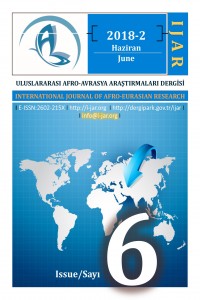Öz
Türk
dilinin yazılı kaynakları açısından Kutadgu Bilig önemli bir yere sahiptir.
Zira 1900’lü yılların başında Divanu Lugati’t- Türk bulunana kadar Türk dilinin
elde bulunan ilk yazılı kaynağı olarak Kutadgu Bilig kabul görüyordu. Bu
kabulden dolayı eser çok büyük ilgi görmüş, Türkçenin erken dönemleri ile
ilgili tespit ve tahminler bu ilginin neticesi olarak ortaya çıkmıştır. Tabii
ki bu durum eser üzerinde sayısız çalışma yapılmasına sebebiyet vermiştir.
Yerli ve yabancı Türkologların geçmişte yaptığı çalışmalar neticesinde eserin
zenginlikleri büyük oranda ortaya çıkarılmıştır. Kültürel, sosyal, tarihi ve
dilsel yönlerden büyük değer taşıyan Kutadgu Bilig günümüzde de birçok
çalışmaya kaynaklık etmektedir. Bu çalışmalar ile eserin mahiyeti daha da
belirginleşmektedir.
Eserin
dilsel bir yönünü irdelemek amacı ile kaleme alınan bu yazıda ise Kutadgu
Bilig’in bazı beyitlerindeki sıfat-fiil kullanımları incelenecektir. Bu
beyitler; 470-580, 645-830, 950-970 beyitleridir. Sıfat-fiiller hakkında giriş
mahiyetinde bilgi verildikten sonra Orta Türkçe’de kullanılan sıfat-fiil ekleri
verilmiş ve bu eklerin üzerinde durduğumuz beyit aralıklarındaki kullanımları
incelenmiştir. Sıfat-fiil ekleri işaret ettikleri zamana göre sınıflandırılmış
ve örneklerdeki fonksiyonları üzerinde durulmuştur. Kısaca haklarında bilgi
verilen eklerin geçtiği beyitler verilmiş böylece vazifeleri örnek üzerinde
gösterilmeye çalışılmıştır. Belli beyit
aralıklarını irdeleyen çalışmanın neticesinde, sıfat-fiil kullanımları hakkında
bazı çıkarımlarda bulunulmuştur. Bazı eklerin işlek olarak kullanılmışken
bazılarının ise işlek olmadığı tespit edilmiştir. Böylece Kutadgu Bilig’de
sıfat-fiil kullanımı hakkında bir çerçeve çizilmeye çalışılmıştır.
Anahtar Kelimeler
Kaynakça
- Akar, A. (2015). Türk Dili Tarihi, Ötüken Yayınları, İstanbul.
- Arat, R. R. (1991). Kutadgu Bilig I Metin, TDK Yayınları, Ankara.
- Arat, R. R. (1991). Kutadgu Bilig Çeviri, Türk Tarih Kurumu Yayınları, Ankara.
- Argunşah, M. ve Yüksekkaya, G.S.( 2015). Tarihi Türk Lehçeleri “Karahanlıca, Harezmce, Kıpçakça” Dersleri, Kesit Yayınları, İstanbul.
- Banguoğlu, T. (2015). Türkçenin Grameri, TDK Yayınları, Ankara.
- Ercilasun, A. B. (2008). Başlangıçtan Yirminci Yüzyıla Türk Dili Tarihi, Akçağ Yayınları, Ankara.
- Ergin, M. (2013). Edebiyat ve Eğitim Fakültelerinin Türk Dili ve Edebiyatı Bölümleri İçin Türk Dil Bilgisi, Bayrak Yayıncılık, İstanbul.
- Gabain, A. V. (2007). Eski Türkçenin Grameri, (Çev.) Akalın, M. TDK Yayınları, Ankara.
- Hacıeminoğlu, N. (2013). Karahanlı Türkçesi Grameri, TDK Yayınları, Ankara.
- Korkmaz, Z. (2011). Türkçede Eklerin Kullanılış Şekilleri ve Ek Kalıplaşması Olayları, TDK Yayınları, Ankara.
- Radloff, W. (1910). Das Kutatku Bilik des Jusuf Chaas Hadschib aus Balasagun II, St. Petersburg, (Akt.) Caferoğlu, A. (2015). Türk Dili Tarihi II, Altınordu Yayınları, Ankara.
- Tekin, T. (2003) Orhon Türkçesi Grameri, (Haz.) Ölmez, M. Türk Dilleri Araştırmaları Dizisi, İstanbul.
Öz
Kutadgu
Bilig has an important place in terms of the written sources of the Turkish
language. Because at the beginning of the 1900's, Kutadgu Bilig was accepted as
the first written source of Turkish language until Divanu Lugati't Türk was
found. Due to this acceptance, the work has attracted a great deal of attention
and the findings and estimates of the early periods of the Turkic have emerged
as a result of this interest. Of course, this situation has caused numerous
works on the work. As a result of the work of local and foreign Turkologists in
the past, the wealth of their work has been revealed in great measure. Kutadgu
Bilig is of great value in terms of cultural, social, historical and linguistic
aspects. With these works, the nature of the work becomes more apparent.
In
this article, which is aimed at analyzing the linguistic direction of the work,
the use of participes in some couplets of Kutadgu Bilig will be examined. These
couplets; 470-580, 645-830, 950-970. After the introduction of participes, we
have given participe suffixes used in Middle-Turkic languages and examined the
use of these suffixes in couplet intervals. The participes suffixes are
classified according to the time they pointed out and the functions of the
examples are emphasized. Briefly, the couplets to which the annexes given
information are given have been given so that attempts have been made to show
the appointments on the sample. Some conclusions have been made about the use
of participes in the context of the study of certain couplet intervals. Some
supplements have been found to work, while others have not. Thus Kutadgu Bilig
tried to draw a framework for the use of participes.
Anahtar Kelimeler
Kaynakça
- Akar, A. (2015). Türk Dili Tarihi, Ötüken Yayınları, İstanbul.
- Arat, R. R. (1991). Kutadgu Bilig I Metin, TDK Yayınları, Ankara.
- Arat, R. R. (1991). Kutadgu Bilig Çeviri, Türk Tarih Kurumu Yayınları, Ankara.
- Argunşah, M. ve Yüksekkaya, G.S.( 2015). Tarihi Türk Lehçeleri “Karahanlıca, Harezmce, Kıpçakça” Dersleri, Kesit Yayınları, İstanbul.
- Banguoğlu, T. (2015). Türkçenin Grameri, TDK Yayınları, Ankara.
- Ercilasun, A. B. (2008). Başlangıçtan Yirminci Yüzyıla Türk Dili Tarihi, Akçağ Yayınları, Ankara.
- Ergin, M. (2013). Edebiyat ve Eğitim Fakültelerinin Türk Dili ve Edebiyatı Bölümleri İçin Türk Dil Bilgisi, Bayrak Yayıncılık, İstanbul.
- Gabain, A. V. (2007). Eski Türkçenin Grameri, (Çev.) Akalın, M. TDK Yayınları, Ankara.
- Hacıeminoğlu, N. (2013). Karahanlı Türkçesi Grameri, TDK Yayınları, Ankara.
- Korkmaz, Z. (2011). Türkçede Eklerin Kullanılış Şekilleri ve Ek Kalıplaşması Olayları, TDK Yayınları, Ankara.
- Radloff, W. (1910). Das Kutatku Bilik des Jusuf Chaas Hadschib aus Balasagun II, St. Petersburg, (Akt.) Caferoğlu, A. (2015). Türk Dili Tarihi II, Altınordu Yayınları, Ankara.
- Tekin, T. (2003) Orhon Türkçesi Grameri, (Haz.) Ölmez, M. Türk Dilleri Araştırmaları Dizisi, İstanbul.
Ayrıntılar
| Birincil Dil | Türkçe |
|---|---|
| Bölüm | Makaleler |
| Yazarlar | |
| Yayımlanma Tarihi | 30 Haziran 2018 |
| Yayımlandığı Sayı | Yıl 2018 Cilt: 3 Sayı: 6 |
All rights reserved. International Journal of Afro-Eurasian Research (IJAR) is an International refereed journal and published biannually. Authors are responsible for the content and linguistic of their articles. Articles published here could not be used without referring to the Journal. The opinions in the articles published belong to the authors only and do not reflect those of International Journal of Afro-Eurasian Research.

